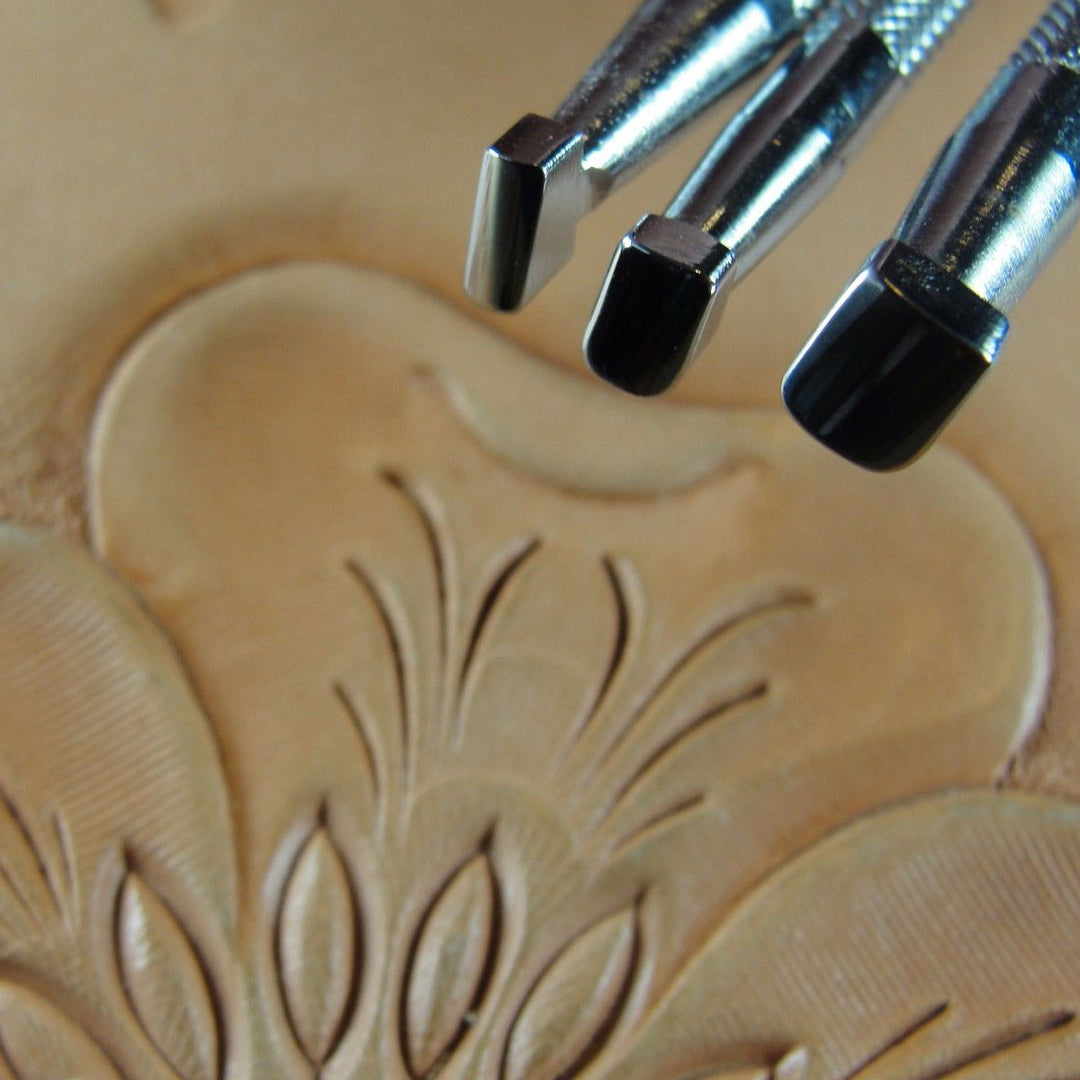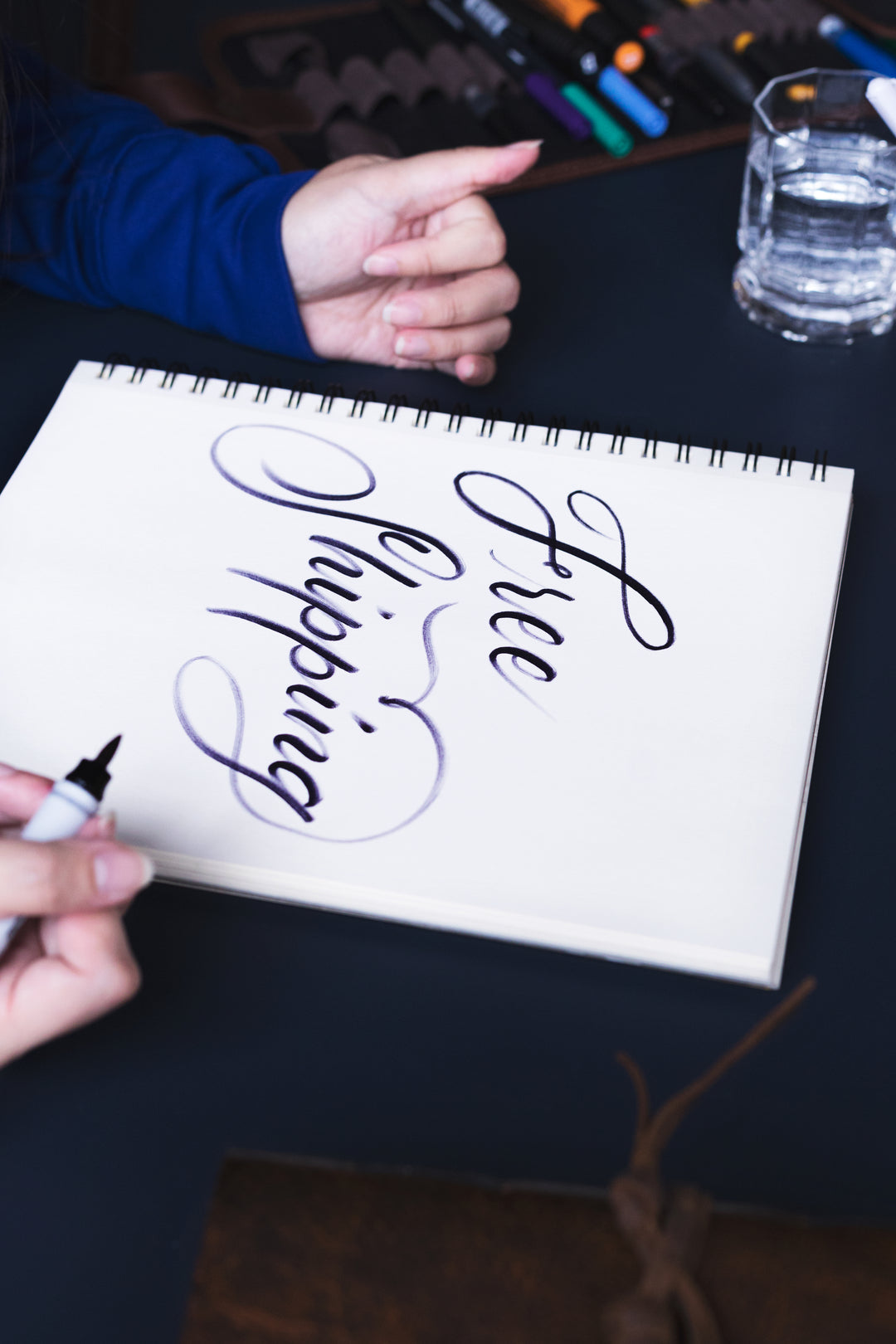Jim Linnell
My recollections of leatherworking are some of the earliest memories I have. I was born and raised on a ranch in eastern Montana about 50 miles from the nearest town, Miles City. Our trips to town every 2 to 3 weeks were big events because, not only did we get to stop by the soda fountain at Woolworth’s, but we would often stop by the Miles City Saddlery. Though I was too young to remember most of the details of those visits, what I do remember are the sounds and smells of that shop.
The neighbor that had the ranch just west of us (about 7 miles away) did a little leatherwork and it was at his bench that I had the first opportunity to stamp on some leather. I was probably in the 2nd or 3rd grade when I got this first chance to try my hand at stamping.
My first real introduction to leatherworking was in 1967 at the age of 11, when I had some instruction in leatherwork in a 7th grade industrial arts class. The three projects that I made during that class whetted an appetite for leatherwork that I’ve had every since.
Soon after that class, I answered a small ad in Outdoor Life for a Spiral Line wallet kit from Tandy Leather Company. Along with the kit came a Tandy catalog and I soon pestered my folks into buying me a Lucky 7 tool set. With my own tools, I started making leather stuff for anybody that I could talk into buying me a kit.
When I got to high school, they offered a crafts class where you could do leatherwork among several options. This sounded like a class I could get good grades in without having to work too hard, so I took it for 3 years. Mr. Matross was my teacher and he actually knew quite a bit about leatherwork and helped me do some work I was actually proud of.
He introduced me to some instruction books he had that were written by Al Stohlman and I was amazed at the kind of detail that could be carved into leather. I used to study those illustrations and try to do work that was as good, but mine always came short of what I saw. I became convinced that the photography had to make Al Stohlman’s work look better than it was. Many years later when I had my first chance to actually see and examine some of Al’s work I realized that the photos didn’t do his work justice. This realization definitely humbled me, but it also inspired me in that I now knew that it could be done. Over the years, when asked where I learned to carve leather, I have answered that Al Stohlman taught me. Though I never had the privilege of meeting him, Al Stohlman has been my inspiration.
While in high school, I discovered that I could make a little money selling the things that I was making. I wasn’t charging much back then, but I tried to make enough so I could buy a few tools or a new book or pattern. I didn’t make much money, but I got the thing I need most. Practice!!
After high school, I was doing a little leatherwork on the side for friends and family, but really not much until one day I walked into Boyd’s Boot & Saddle. I just walked in and asked them if they had anyone doing custom leatherwork for them. They said they had a lot of customers that asked for things, but they really didn’t have anybody doing the work. I told them that I did a little, so they asked to see some of my work. I went home, made a wallet and took it back up to them that afternoon. They liked my work and the fact that I could turn it out fairly quick, so they sent me home with a half dozen orders. I ended up doing most of their custom work for the next 3 or 4 years.
While working for Boyd, I also started tooling saddles for Jim Beeman, a local saddle maker. Jim built a great saddle, but he really didn’t like tooling, so he had me do all of that kind of work for him. Once again, all this work gave me the practice and confidence I really needed to develop my own style.
Boyd’s Boot & Saddle was an authorized Tandy Leather Dealer. They wanted to develop a customer base for their products and so they asked me if I would consider teaching classes at their store. I told them that I didn’t think I knew how to teach, but I’d be glad to show folks how to do what I do. I ended up teaching 3 or 4 classes a year for them.
In 1978 I was working in the construction business during the day and carving leather at night. I happened to be working a job in Billings, MT and one day while reading the newspaper, I saw that Tandy Leather Company was looking for somebody to get into their manager-training program. I wasn’t sure I wanted to be a manager, but the Idea of working in the leather business sounded like something I might want to do, so I went in and checked it out.
The first thing I found out was that I’d be making less money and working more hours, but there might be some opportunity to grow if I stuck with it. My family thought I was nuts to consider such a job, but my sweet wife told me that we would manage if that’s what I wanted to do. So one Friday afternoon I quit an $11.00 an hour job (a lot of money in 1978) and went to work the following Monday for $2.65 an hour. I must have been young and stupid at the time.
I absolutely loved the work I was doing. I started doing leatherwork demonstrations every week at schools and for youth groups all over Montana, as well as teaching classes in the store in the evenings. I remember visiting a school in Sydney MT, where I introduced leathercraft to 8 classes of about 25 junior high, industrial arts students (200 jr. high kids?) in one day. Long day!!
Another time I had a workshop set up with the 4-H extension office in Lewistown, MT. It was going to be a 4-hour workshop. When I got there, I couldn’t find a place to park. I had been told to anticipate around 30 people, but when I counted heads, there were over 175 parents and kids there to learn about leatherwork. I ended up having to schedule 2 more workshops just to accommodate the crowd.
I managed Tandy Leather stores in Cheyenne, WY and Tacoma, WA and spent 4 years as a regional manager overseeing stores in 9 Rocky Mountain States before ending up in Ft. Worth, TX.
Over the 18 years I spent with Tandy Leather Company, I have no idea how many demonstrations, classes and workshops I have given. The number is surely well into the thousands. When I think of all the places I’ve done these demos it brings back some great memories. I’ve done leatherwork demonstrations in elementary schools, junior high schools, high schools, universities, veteran hospitals, occupational therapy clinics, nursing homes, 4-H camps, Scout camps, YMCA camps, and so many other venues I can’t remember.
I’ve done leatherwork demos in most of the states west of the Mississippi including Hawaii, and I can’t even begin to guess how many people have been in attendance. The number has to be well into the tens of thousands.
I took a short detour from the leather industry when I took over one of Tandy Leather Company’s sister companies for a while. I was president of Joshua’s Christian Stores for 7 years, and while I wasn’t directly involved in the leather business, I still made samples for the local Tandy stores in my spare time.
My office happened to be just across the hall from the Tandy Leather research & development department. Whenever I was missing from my office, my employees knew they could find me across the hall talking with Harry Resinger and Tony Laier.
I left the Tandy family in 1996, but my appetite for leatherwork was still strong. A year or so later, I and a couple of friends started Texas Wholesale Leather, Inc. This really brought about the first opportunity for any of my work to be published. While in the process of getting this business off the ground, I started doing some leatherwork for use in some of our advertising. I didn’t think it was any big deal, but people started wanting to know who this new guy was that was tooling leather for Texas Wholesale Leather. I was doing the same kind of work I always had, but now people were seeing it in publications. It was like I was a newly discovered talent in the leather world.
George Hurst moved his business, Hide Crafters Leathercraft, into some extra space that we weren’t using. I had worked with George at Tandy Leather Co., but he had no idea what kind of a leatherworker I was. He got me involved with the Lone Star Leathercrafter’s Guild, which gave me the opportunity to exhibit my work at their annual convention. I was amazed at the results. Getting ribbons, awards and recognition for the things that I love to do was something I never dreamed of.
George also asked me to do an instructional video for him, which I did, and soon after I also did the cover for his catalog. Getting these things circulated seemed to bring a lot of attention my way and has let me share my talent with countless leatherworkers around the world.
In November of 1999 I joined Hide Crafter Leathercraft and for the next 2 years worked with George Hurst to grow his business, bringing a good number of new tools, video’s and patterns to the market. I have continued to stay active, doing a lot of teaching not only at the various leather shows around the country, but also with many workshops and classes held at the store.
One of the more significant events that has happened in the leather industry over the last few years was the closing of all of the Tandy Leather Company retail stores. This event broke my heart. It also made finding a place where interested people could be introduced to Leathercraft a very difficult task. In January of 2002, I was asked to take on a new challenge. I took on the position of Director of Operations for Tandy Leather Company with the charge to re-establish a chain of Tandy Leather Stores once again. The rest of this story is yet to be written.








